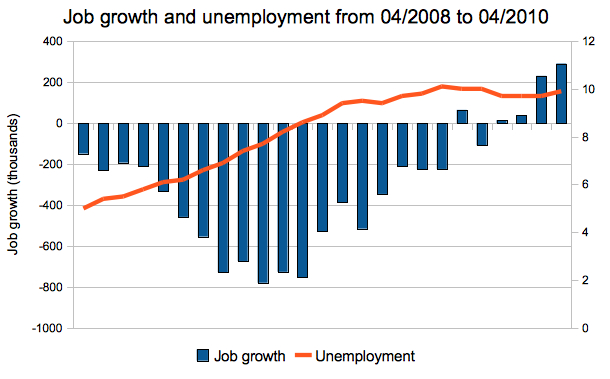You might have heard that the U.S. added 290,000 jobs in April. At the same time, the unemployment rate rose! Bwhat!?
The unemployment rate doesn’t measure how many people are unemployed. It sounds like it should, being that it includes the words “unemployment” and “rate” and all, but it doesn’t. Instead, the unemployment rate measures how many people are looking for jobs. When things are really bad, some people get discouraged and give up, or go to school instead, or stay home to take care of their kids and save day care money.
So the number of jobs and the unemployment rate are not directly correlated. Ezra Klein posted this visual:
It shows unemployment rising as job growth remains negative, leveling off as (perhaps) people drop out of active job seeking, and than actually going up again there at the end in response to two months of solid job growth.
So it turns out that, in this case, a rise in the unemployment rate is good news. It means some people are hopeful again.
Lisa Wade, PhD is an Associate Professor at Tulane University. She is the author of American Hookup, a book about college sexual culture; a textbook about gender; and a forthcoming introductory text: Terrible Magnificent Sociology. You can follow her on Twitter and Instagram.

Comments 16
jfruh — May 10, 2010
It's also the case that, because America still has a net growth rate (births + immigration > deaths + emigration), there needs to be an increase in the absolute number of jobs just to keep the relative employment rates even. In other words, if 100,000 jobs are created, but 120,000 new people start looking for work, the unemployment rate will still go up.
rowmyboat — May 10, 2010
That, or they've run through their savings/graduated from school/are no longer doing whatever they were doing, and now they really need a job.
Beelzebub — May 10, 2010
U-3 and U-6 measures increased by the same amount, so I'm not entirely sure I buy this. U-6 already measures people who are unemployed, but aren't looking for work because they are discouraged. On the other hand, U-6 also measures those who have part-time work, want full-time work, but can't get it.
thewhatifgirl — May 10, 2010
What happens to those who quit looking for jobs?
John Schmertz — May 10, 2010
I've put together a series of charts on both inflation and unemployment that I thought you folks might appreciate. Click on a thumbnail to view the interactive flash version. Enjoy!
http://www.thumbcharts.com/series/inflation-rate-1913-2010
http://www.thumbcharts.com/series/us-unemployment-rate-1948-2010
http://www.thumbcharts.com/series/inflation-and-unemployment